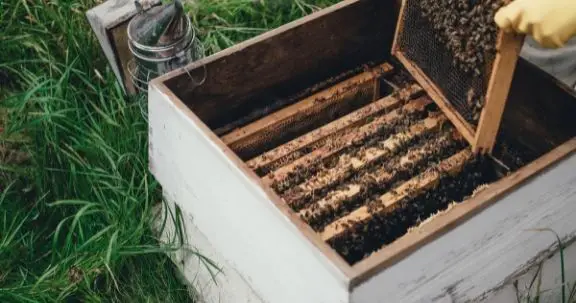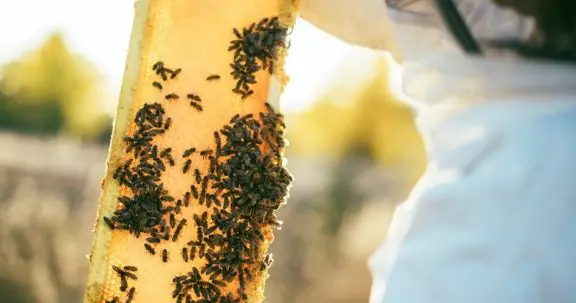I’m sure that there are many beekeepers out there – perhaps most – that do not feel the need to eat honey beyond what comes from their own hives. After all, why would you pay for honey, when you have more than enough of your own? Well, after reading The Honey Connoisseur, you’ll have all the reasons you need to want to try every honey on the planet.

The Honey Connoisseur: Selecting, Tasting, and Pairing Honey, With a Guide to More Than 30 Varietals is a brand new book by well-known authors Marina Marchese and Kim Flottum. Many beekeepers will recognize Flottum’s name from several well-known books including The Backyard Beekeeper, Better Beekeeping, and contributions to The ABC & XYZ of Bee Culture. Marchese wrote the first beekeeping book that I ever read, Honeybee: Lessons from an Accidental Beekeeper. Together, this dynamic duo has created an excellent resource for honey lovers everywhere (whether beekeepers or not).
When I first picked up this book and started flipping through the pages, it became immediately apparent that there was a huge amount of material in this book. Even more evident was that an extraordinary amount of research and scrutiny would have been required to write such a detailed book. The book is broken up into several sections; basic information on honeybees and beekeeping, honey “terroir” and geographic regions, instructions on how to smell and taste honey, as well as pairing honey with different foods and throwing a honey tasting party.
The largest section of this book by far is devoted to describing – in great detail – many different types of honey. Flottum and Marchese examine over thirty common and exotic floral sources which create some of the most interesting honey in the world. I loved reading about flowers and honey that I’ve never heard of before and their interesting tasting notes and physical properties. For example, who knew that grapefruit honey is extremely thixotropic, meaning that it sets up in a thick gel until you shake it? Or that Saw Palmetto is considered one of the finest honey in the world. Not me!
There were more than a few times while reading through the honey varietals, that I thought to myself, “this would make an excellent coffee table book!” (and I mean that in a very good way). I think that just about anyone would love to pick up this book and start reading about honey-like Kudzu, Sidr, Tamarisk, or Manuka.
Having read a large number of beekeeping books, it was quite refreshing to read The Honey Connoisseur and learn all sorts of new, fascinating stuff about honey. Even though both Marchese and Flottum keep bees, you definitely don’t need to be a beekeeper to appreciate this book or the honey that it presents.
This would be an excellent book for foodies or anyone that appreciates a great glass of wine, a slice of fine cheese, or just someone with a sweet tooth for honey. The Honey Connoisseur has an excellent section on creating a honey tasting party for your friends, including instructions on how to prepare tasting flights and set up an Aroma Sensory Table, all complete with mouth-watering photographs of food, and honey pairings, and a few simple recipes.
I walk away from this book with a new appreciation for honey. I will no longer be satisfied eating only the honey that my bees produce. I will be visiting farmer’s markets, visiting apiaries in rural areas, and keeping my eyes open for exotic honey while traveling.
Suspected ChalkBrood
Yesterday was a beautiful day and I headed out to the hives to check up on them before the weather gets cool again and we head into winter. One of my Langstroth hives (which I’ve named L1) hasn’t really been doing so great recently. It hasn’t been “bubbling with bees” the way it was last year, nor has it been very productive. Also, the bees have been pretty irritable for the last month or so. All that being said, there was no obvious sign of problems (at least not to me). The queen has been laying, and there have always been “enough” workers.
Yesterday I noticed some interesting “mummified” bees near the entrance and on the bottom board. I took some pictures of the bees and when I got home, I went through some of my reference books and of course, the Internet. My best guess is that this hive has a fungal disease called Chalkbrood.
Chalkbrood is a disease that affects honeybee larvae. It’s caused by a fungus called Ascosphaera Apis. I’m not sure how this colony would have gotten infected with Chalkbrood, but now I will be exploring treatments. This is a fungus and it thrives in damp locations, so my first order of business will be to add more ventilation to this hive. I will also reduce the size of this hive from 3 deep boxes to 2, removing some of the now-empty frames before the winter.
It’s a bit unnerving seeing the state of this hive so close to winter, and I fear they won’t survive the cold season. Luckily this does not seem to have spread to my other hives though. Fingers crossed.
Honeybees Swarm in August
A couple of weeks ago, I noticed some queen cells in my top bar hive. At the time, I thought they were supersedure cells, but it turns out I was wrong.
On the evening of August 7, I got a call that my bees had swarmed a nearby pine tree. This certainly caught me off guard. I knew there were queen cells in there, but I didn’t expect this colony to split and swarm, especially this late in the season. Unfortunately, this swarm left before I had a chance to retrieve them. I even reached out to some other local beekeepers, but they were gone by the morning of August 8 – hopefully to a nice new home.
This colony was originally a swarm that I captured early in the year. They are an extremely strong colony and excellent producers who work quickly and efficiently. I guess they also have a genetic trait that gives them a strong instinct to swarm.
Overall, I’m not too bothered that they have swarmed. It would have been nice to provide them with a new home and have another strong colony, but I’m happy knowing that this colony is going to be out in the wild, and reproducing.
Supersedure Cells in Top Bar Hive
UPDATE: It turns out these were swarm cells and half of these bees swarmed on Aug 7. I didn’t expect them to swarm this late in the season, but I guess the swarm instinct was strong.
Yesterday, I inspected my top bar hive. It had been a week and a half since I last visited them. The colony is doing excellent aside from some slight cross combing that is happening at the back, in the honeycomb. The queen is definitely very active and thorough with a great laying pattern and signs of brood in all stages of development.
However, on three of the bars that I examined, I found open supersedure cells like the ones pictured above. They caught me a bit by surprise and I’m not sure why they were there. I believe I saw at least one larva inside these cells, but it was very difficult to see inside.
I don’t want to remove them, because I trust that the bees know what they’re doing better than I do. Perhaps the queen is maimed or very old. Otherwise, this is an extremely healthy colony. Perhaps these are just empty cells to be used in case of an emergency.
How to Get Bees Out of Trees

When I received an email from Kelly McLachlin explaining that she had an established colony of honeybees living in a Beech tree in her backyard, I was obviously very intrigued. I had her send me pictures of the tree and the bees and I was still slightly confused. I knew how much hollow space honeybees needed to make their hive and it was perplexing to see them coming and going from a crack in a seemingly solid and healthy tree. When I arrived on-site, however, things started to become clearer.
THE TRAP-OUT
Another beekeeper, Marco, and I set out to extract this colony without harming the bees or the tree. Kelly was very accommodating and we decided to try a “trap-out”. This method of honeybee extraction includes setting up a bee escape to allow foraging bees to leave the hive, but not return afterward. To coax them into a new hive, a young brood is used to lure the worker bees inside. If all goes well, the bees will raise a new queen from one of the eggs inside the new hive.
This trap-out process can take up to six weeks before the bees have all left the original tree, and it’s very likely that the original queen will never leave. She will die in her empty palace filled with honey. After the extraction, the tree will need to be sealed up completely, otherwise, the homeowner stands a very good chance that a new honeybee colony will move right in next year.